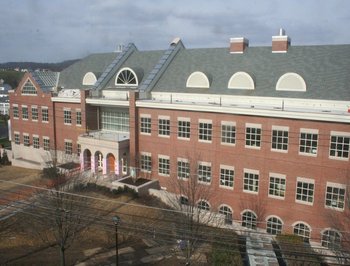New Science Building - Susquehanna University
The New Science Building at 75,000 square feet is the largest academic building on Susquehanna University's campus. The building marks another project designed around Susquehanna University's initiative to go "green." The project is designed around the USGBC LEED New Construction & Major Renovation Version 2.2 Criteria and will be submitted to the USGBC for LEED review and certification. Over five million dollars of mechanical and plumbing equipment make up the state-of-the-art science facility.
The mechanical system highlights capture and re-use of energy through the lab classroom ventilation system. Forty-five exhaust valves serve science room fume hoods and general exhaust to provide a continuous negative pressure inside lab classrooms. The air that is exhausted is sent through an energy recovery unit before being exhausted to atmosphere through twenty-six diameter exhaust stacks. The energy captured by the energy recover unit is transfered via a water/glycol loop to another air handlng unit that provides outside air for ventilation and non-lab classroom return for supply air to the building. The energy captured either heats or cools the incoming outside air depending on season. The incoming outside air is modulated to meet the needs of the occupancy of the building through occupancy sensors and CO2 sensors installed in the classrooms; this prevents unnecessary heating or cooling of outside air. Supply air is then provided to both the lab and non-lab classrooms as determined by the occupancy sensors and the variable air volume boxes and supply valves in the space. In addition to the science fume hoods there are also fourteen fume extractor arms, eight located in one classroom on the second floor to allow experiments and tests to be done on the science work benches. The exhaust valve, science fume hoods, and energy recovery unit are tied together using stainless steel ductwork. Sound attenuators are also located in the ductwork, predominantly in the penthouse, to mitigate any potential concerns regarding noise. At any one time the building may exhaust up to 51,000 CFM of air. A pure water system provides pure water throughout the classrooms and labs in the New Science Building. The pure water system is a continuous loop that runs from the penthouse down to the 1st Floor back to the penthouse in order that the water does not stagnate. Carbon filters, reverse osmosis units, ultra violet light, and pure water filters and polishers provide ASTM Type II quality pure water. Schedule 80 fused polypropylene piping is used to transport the pure water and dedicated ultra-pure water polishers are located in designated classrooms and lab for additional water purification. The pure water is available at dedicated faucets and fume hoods. The New Science Building also includes an oil-less air compressor, a duplex vacuum pump, and natural gas piping for air, vacuum, and gas use in the classrooms and labs. Designated rooms include stainless steel piping and gas manifolds for helium, argon, carbon dioxide, nitrogen, and hydrogen/nitrogen lab gases. Gas-fired hot water heaters provide the domestic hot water for use throughout the facility with an electric hot water heater for re-circulation. Four gas-fired 2000 MBH 99% efficient boilers provide comfort heating and hot water reheat to the VAV boxes while two 167 Ton Chillers provide comfort cooling. In off-peak season two 8 Ton Process Chillers located in the Penthouse may be used for comfort cooling as well as dedicated cooling to the buildings six Critical Room Air Conditioners serving data and electrical closets. The Greenhouse on the Penthouse level is conditioned by hot water unit heaters and stainless steel enclosed fin tube radiation. The project completed on March 5, 2010, finishing several weeks ahead of schedule. Early completion of the project allowed for construction and renovation to begin on Fisher Science Hall; Silvertip Incorporated is also the mechanical contractor for the Fisher Science Hall project which takes place the summer of 2010.
































